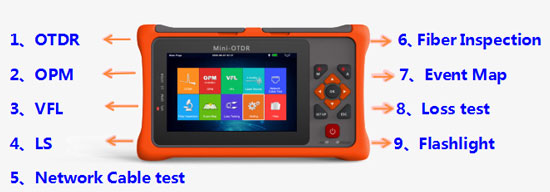Multi-functional mini optical domain reflectometer for sale, supporting nine functions including OTDR, OPM, VFL, LS, Network Cable test, Fiber Inspection, Event Map, Loss test, and Flashlight. OTDR fiber tester is powered by a 3.7V/4000mAh/14.8Wh lithium battery, intelligent power-saving management, and continuous testing for more than 10 hours.

Multifunctional Mini OTDR optical time domain reflectometer
- Nine-in-one function (OTDR, OPM, VFL, LS, Network Cable test, Fiber Inspection, Event Map, Loss test, Flashlight).
- 4.3-inch full-view capacitive touch screen with multi-touch support.
- International standard test data, with perfect simulation software, make your report easier.
- Sink-type lamp port design, so that the optical time domain reflectometer lamp port is better protected.
- Support uploading data to PC via USB port for further data analysis, processing and printing test results.
Application
OTDR (optical time domain reflectometer) uses the backward scattered light generated when the light propagates in the fiber to obtain attenuation information, which can be used to measure fiber attenuation, splice loss, fiber fault location and understand the loss distribution along the length of the fiber, etc. OTDR tester is an essential tool in fiber optic cable construction, maintenance, and monitoring.

| Model | SISCO-TM1100-A22D |
| Wavelength | 1310/1550nm |
| Dynamic Range | 22/20dB |
| Measuring Range | 100m, 500m, 2km, 5km, 10km, 20km, 40km, 70km |
| Sampling Resolution | Minimum 0.2m |
| The Sampling Point | 64,000 Point |
| Inearity | ≤0.05dB/Db |
| Loss Threshold | 0.01dB |
| Loss Resolution | 0.001dB |
| Range Resolution | 0.01m |
| Range Accuracy | ±(0.5m+Range×3×10-5+Sampling resolution) (Excluding refractive index error) |
| Memory | >100000 |
| VFL | 10mW,CW/2Hz |
| Data Interface | 2xUSB(Type A x 1,Micro USB x 1, SD card |
| Screen | 4.3-inch TFT-LCD (Standard distribution capacity touch screen) |
| Battery | 3.7V/5200mAh |
| Working Temperature | -10℃~+55℃ |
| Storage Temperature | -20℃~+80℃ |
| Humidity | ≤95%(No condensation) |
| Dimension | 175x105x45mm |
| Weight | 0.56kg(Contain the battery) |
| Attachment | Power adapter, lithium battery, FC adaptor, USB cable, quick guide, portable package |
| OPM | Type A: -10dBm~-70dBm, Type B: +26dBm~-50dBm |
| LS | The output power:-5dBm,Modulation frequency:CW/270Hz/1KHz/2KHz |
| Network Cable Test | Network Cable test |
Q1: What is an OTDR used for?
A1: OTDR is a fiber optic instrument used to characterize, troubleshoot and maintain optical communication networks. OTDR testing is performed by transmitting and analyzing pulsed laser light through an optical fiber.
Q2: What is fiber loss?
A2: Optical fiber loss is the attenuation per unit length of optical fiber in dB/km, the level of fiber loss directly affects the transmission distance or the distance between relay stations, therefore, understanding and reducing the loss of optical fiber is of great practical significance for fiber optic communication.
Q3: What is an optical time domain reflectometer?
A3: The optical time domain reflectometer is a fiber optic tester used to test the characteristics of optical communication networks. OTDR is designed to detect, locate and measure events at any location on a fiber optic link. OTDR requires access to only one end of the link and works in a manner similar to a one-dimensional radar system. By providing graphical trace characteristics of the fiber under test, the user can obtain a graphical representation of the entire fiber link.
Tips: How to choose the wavelength of the OTDR fiber optic tester?
1550 wavelength test distance is longer, 1550nm than 1310nm fiber more sensitive to bending, 1550nm than 1310nm unit length attenuation is smaller, 1310nm than 1550nm measured fusion or connector loss is higher. In the actual fiber optic cable maintenance work is generally tested and compared for both wavelengths. For positive gain phenomenon and over the distance line are required to carry out two-way test analysis and calculation, in order to obtain a good test conclusion.
Thank you for buying industrial test and measurement equipment on SISCO.com, all products sold by SISCO and the partner cover a 12 months warranty, effective from the date of receiving the products.
What is covered?
SISCO is responsible for providing free spare parts, and free technical support to assist the customer to repair the defective products until the problem is solved.
What is not covered?
- Product purchased from anyone other than a SISCO store or a SISCO authorized reseller.
- Expendable parts.
- Routine cleaning or normal cosmetic and mechanical wear.
- Damage from misuse, abuse or neglect.
- Damage from use of parts other than SISCO approved.
- Damage from use outside the product’s usage or storage parameters.
- Damage from use of parts not sold by SISCO.
- Damage from modification or incorporation into other products.
- Damage from repair or replacement of warranted parts by a service provider other than a SISCO authorized service provider.
- Damage caused by the application environment not meeting the product usage requirements and the failure to perform preventive maintenance.

